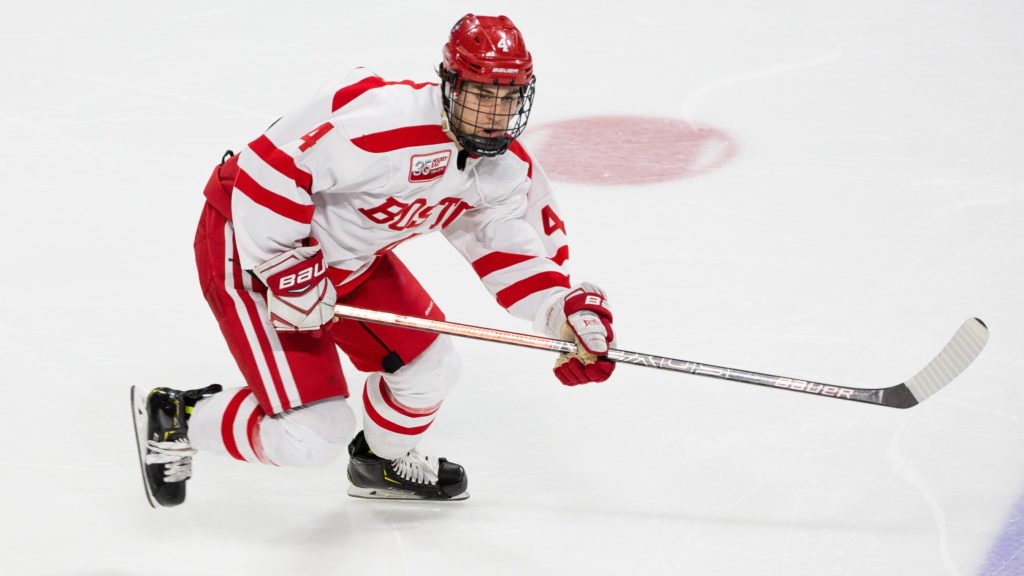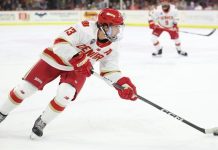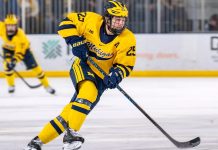
Each week during the season, we look at the big events and big games around Division I men’s college hockey in Tuesday Morning Quarterback.
Jim: Paula, it has been a while since we’ve simply started out Tuesday Morning Quarterback looking directly at the USCHO.com poll, but I feel this week warrants just that.
With No. 1 Boston College letting a late game 3-1 lead slip on Friday, settling for a 3-3 tie and shootout loss against Connecticut, and teams like North Dakota, Minnesota and Minnesota State all sweeping their weekend series, we have the most jumbled top of the poll we have had all season. BC still ended up with the top spot and a total of 19 first-place votes, but all three of the aforementioned teams also ranked top on ballots. Minnesota State received 10 first-place votes but was ranked third. North Dakota with nine first-place votes finished second, while Minnesota pick up the final two first place votes and is ranked fourth, but just 58 points behind Boston College for first.
It seems like each week, the later this crazy season has gone on, that it is more difficult for one team to stand out above all others. In typical years, this is the time of year we’re typically seeing one, maybe two teams pulling away from the national pack.
But not this year.
Why do you suppose that is true?
Paula: My first instinct is to talk about how teams have been playing exclusively within their own conferences or have extremely limited interconference play this season, which may make it even more difficult for us to assess how teams measure up nationally. The scheduling necessities forced by COVID-19 seem like a plausible explanation for why poll voters can’t come to a consensus about those one or two teams who look like locks for the Frozen Four.
But when you think about it for a minute, that doesn’t make as much sense as it should, maybe. Every season at about this time, teams are playing nearly exclusively within their own conferences, pushing toward regular-season titles and playoff positions. The schedule now doesn’t look much different than it did roughly this time a year ago, with notable exceptions like the Beanpot and some nonconference series. By this point in every season, the focus is almost completely on conference play.
Perhaps the answer has something to do with the lateness of the start of the hockey season and the near-complete, all-season-long conference play. While play was accelerated in late 2020 to accommodate full schedules, teams didn’t have the benefit of a long lead-in to the season, the casual team-building, the exhibition and nonconference play, the slower working out of lines, pairings, plays – everything that the first half of a season typically accomplishes, which favors teams that are strong to begin with, like the four that you mention. Instead, teams may still be working out some of those (or even subtler) issues, plus having to adjust behind the scenes to COVID protocols and routines that we never even hear about.
Perhaps, too, the teams that we’re seeing at the top are teams that were going to be good no matter what this season and we were bound to see this kind of parity even without a global pandemic and the weirdness that it brings to college hockey.
Jim: Consistency does seem like it has been an issue for many teams throughout this season, particularly given that there often hasn’t been anything consistent about this season. Stops and starts for teams due to COVID, often meaning that those teams can’t practice for extended periods likely contributes to that lack of consistency.
On a completely different note, it is coming the time that we’re typically talking about the best players and which might be candidates for the Hobey Baker and Mike Richter awards.
This weekend, two players stuck out to me as making great cases. One is Dryden McKay, the goaltender at Minnesota State, who at this point I’d lean toward possibly awarding both awards. McKay has made 10 starts and posted shutouts in six of them including this past Friday. His GAA is 0.90, best in the nation, and his save percentage is .954, ranking third.
Another player who stands out, though having a bit of a limited viewing, is Boston University defenseman David Farrance. In six games, the senior blueliner has 14 points, including four goals. He could be held back by the fact his team has had a limited schedule to date due to the university’s COVID restrictions, but it is also possible if Farrance remains hot, even playing only 20 games, his stats would be too strong to ignore. Farrance could also join Scott Perunovich and Cale Makar to become the third straight defenseman to win the award.
I’ve given you two top players. Who stands out to you right now?
Paula: Two Minnesota players immediately come to mind: senior goaltender Jack LaFontaine and senior forward Scott Reedy.
McKay is the obvious frontrunner for the Richter award, but I haven’t seen a goalie play better than Jack LaFontaine this season. Before the season began, his teammates voted him an alternative captain. His GAA is down from 2.55 to 1.37 and his save percentage has improved from .919 to .949. His consistency in net and his significant improvement from last season to this gave the Gophers the confidence they needed for that quick, decisive start. As we’ve discussed before, Jimmy, that kind of start can carry a team far in a given season, and for Minnesota it meant building on the momentum that they accumulated in the second half of last season.
Reedy is another reason for Minnesota’s fairly quick rebuild, and he has always struck me as a solid player who doesn’t necessarily ring bells on the national scene –reads the ice beautifully, good two-way player, Academic All-Big Ten the last two years. Reedy is among the top players nationally in points per game, is tied nationally for game-winning goals, and is scoring at a greater pace than he did last season. He deserves to be at least discussed among the Hobey finalists.
Before I turn my attention away from the Big Ten, I have to mention the talented Cole Caufield, the sophomore with 10 goals in 16 games for the seventh-best points-per-game total in the nation.
I think a player who should be mentioned is Army West Point junior Colin Bilek, another name that isn’t so obvious. His 10 goals in nine games put him among the leaders nationally in goals per game this season, but that’s not the only reason I’m mentioning him. Should the fact of his promised service be something taken into consideration? This is a conversation we’ve had before, too, regarding the Hobey. There are many ways to measure “strength of character, on and off the ice” – one of the Hobey criteria – but there are few more tangible ways than a commitment to service immediately upon graduation.
For what it’s worth, I think Farrance should be the Hobey frontrunner, but I wonder if it will be as difficult for Hobey voters this year to narrow the field and pick a winner as it is for poll voters to determine top performances week to week – and for the same reasons.
Jim: So the one player from your list that I highly endorse at this point is Cole Caufield. He makes such an impact on that Wisconsin lineup, it’s electric. Sure, the Badgers have more high-end talent, but at this point, it’s Caufield who stands out.
On another note, last week Hockey East announced that we could basically tear up the schedule as games will be scheduled on a week-by-week basis. In a league like that, geographically close for the most part, it is possible. But to me, that seems fair. It’s not a perfect solution but with multiple teams that have had extended pauses and have played limited number of games while others have played nearly every weekend, the only way to find balance it to let the league move on a week-by-week basis.
What do you think? Is that the best method and do you feel like any other league might need to use this in the closing month and a half of this season?
Paula: Geography certainly makes it easier for Hockey East to go to a week-to-week schedule and it makes a lot of sense because of the extended pauses.
I don’t know how feasible this is for the other leagues, but even without the benefits of geography, everyone needs to be able to adjust on the fly. We simply cannot predict what will happen and when – and how that will affect the remainder of the college hockey season.
As you noted in your “Monday 10” this week, Michigan’s athletics are on pause until Feb. 7 because several individuals in the athletic department tested positive for the more aggressive strain of COVID-19 identified in the U.K. The order to halt all activities in the athletic department came from the Michigan Department of Health and Human Services, and U-M is now working closely with the MDHH and the Washtenaw County Health Department to mitigate the spread. Even though no one involved with hockey was reportedly directly affected, everyone in athletics has been ordered to isolate until Feb. 7 and a decision as to what will happen beyond that date hasn’t been made yet.
That postpones Michigan’s series against Penn State Feb. 3-4. The Wolverines are scheduled to play Michigan State Feb. 8 – the day after emerging from isolation, if they are allowed to do so.
Earlier in the season, this wouldn’t have been as big a deal as it is so close to the end of the year. Even if Michigan can play that game against the Spartans and reschedule the Penn State series expediently, they’ll have been affected by that time away from practice.
I think everyone can reschedule postponed series, cramming them in where and when they can before the end of the regular season should the need arise. Going week-to-week across D-I seems unnecessary right now, and let’s hope that doing so doesn’t become a necessity in the coming weeks. We’re so close to finishing the hockey season under truly difficult circumstances. I’d like to think that a year into this, the NCAA will be able to find a way to let student-athletes play to a conclusion of some kind rather than halting abruptly should conditions worsen.
It is surreal that we even have to discuss this.
Fingers crossed.


